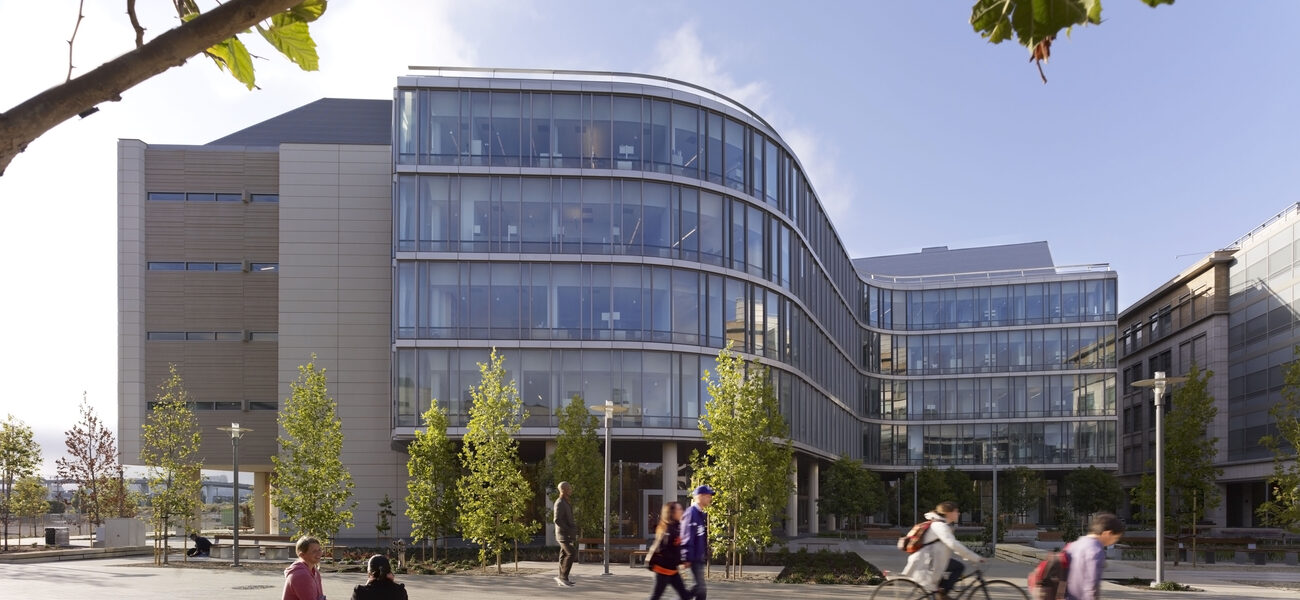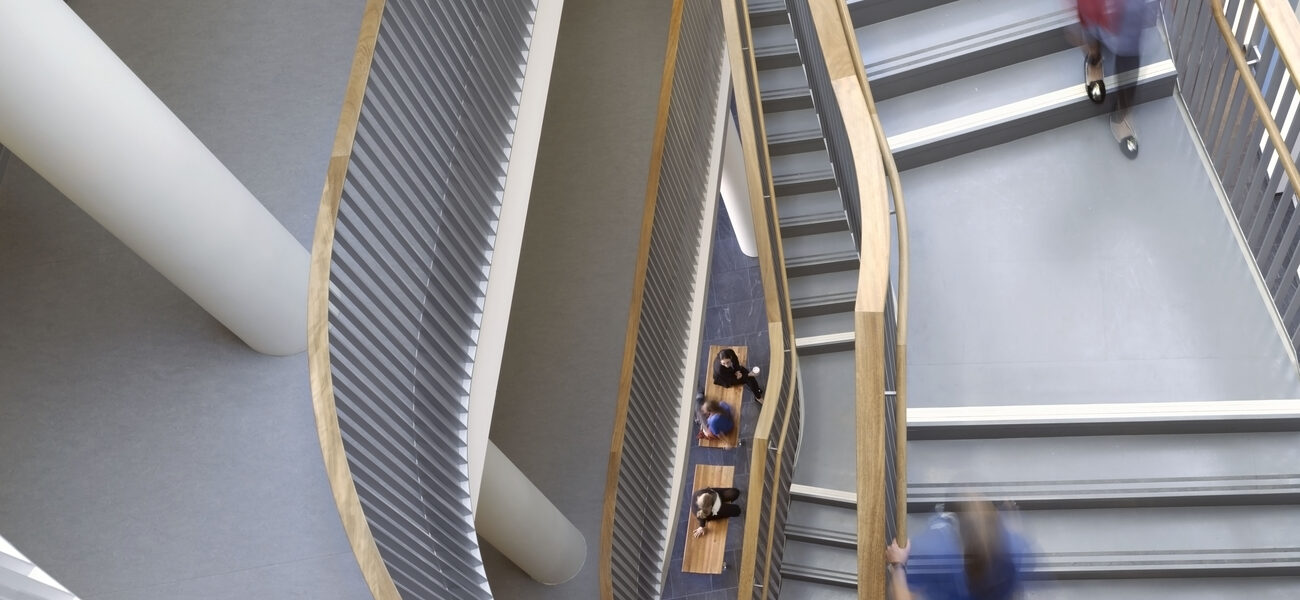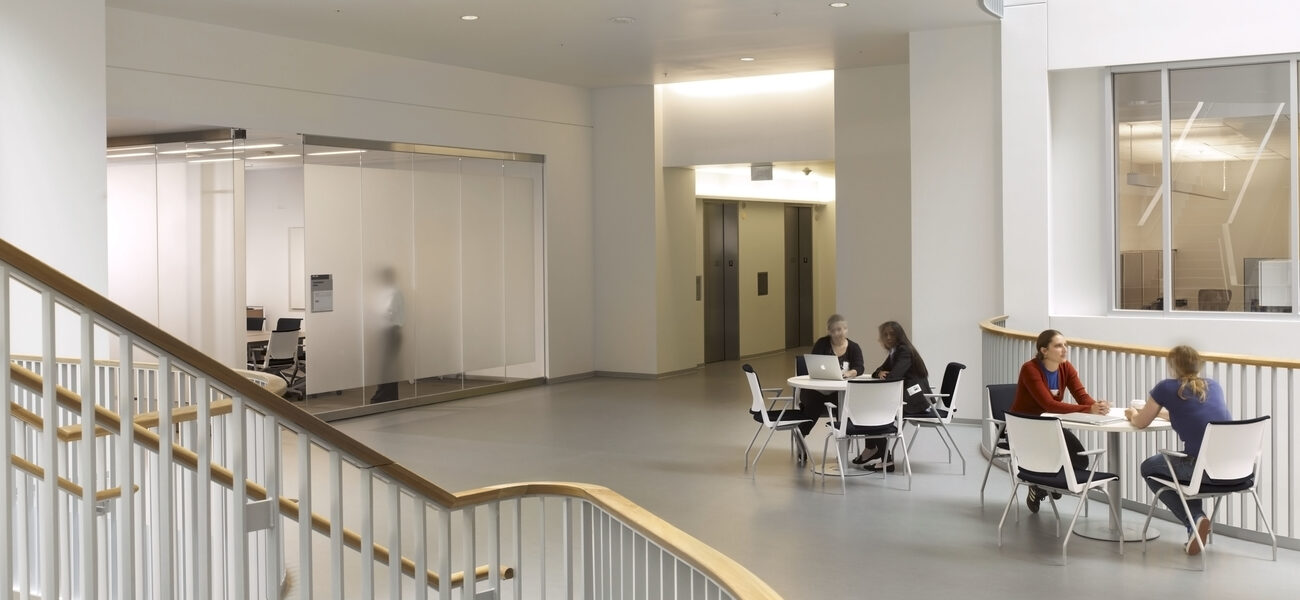The Sandler Neurosciences Center at the University of California, San Francisco (UCSF), is a developer-built facility created through innovative planning, development, design, and research. A public-private partnership—an alternative to the traditional design-bid-build model—applies private-sector efficiencies to an institutional project. Benefits include faster delivery, lower costs to build and operate, and reducing institutional risk by shifting responsibility for construction and ongoing maintenance to the developer.
The new building consolidates UCSF’s major neuroscience research programs—the Center for Integrative Neurosciences, the Neurology Department, and the Institute for Neurodegenerative Diseases—in a collaborative environment, integrating educational research and clinical programs. Current occupants include an interdisciplinary mix of staff from neurology, psychiatry, anatomy, physiology, and otolaryngology departments.
Creating a Public-Private Partnership
UCSF’s multi-campus system includes research, academic, and clinical programs spanning about 7 million sf and 20 locations in San Francisco. The Sandler Neurosciences Center, located on the newest campus at Mission Bay, is the only UC campus focused solely on graduate-level health sciences training. With about 3,000 students, 25,000 faculty and staff, and an annual budget of more than $3 billion, it is the second largest employer in San Francisco.
UCSF’s current capital program calls for developing more than 4.6 million sf on approximately 60 acres. To date, UCSF has built more than 2 million sf in 10 buildings at Mission Bay, at a cost of over $2 billion, including research facilities, a community center, several garage buildings, and student housing.
Over the last three years, the entire university system has experienced a 20 percent reduction in state funding, creating urgency to find new revenue sources, explore partnerships with industry and foundations, and manage and develop its real estate assets, says Esther Morales, executive director of Real Estate Services for UCSF.
“To maintain our standing as a great academic health sciences research institution and support recruitment of the best investigators and faculty, it is critical that we develop models for faster and more efficient delivery of projects,” says Morales.
In 2003, UCSF planned to build a 150,000-sf basic research facility at its Mission Bay campus for the Keck research program in neurosciences, under a traditional design-bid-build process. Lacking sufficient internal capital funds to build it, the project was restructured as a larger 237,000-sf building consolidating several neuroscience research programs, and presented under a ground-lease/lease-back model.
The public-private partnership, approved by the Board of Regents in 2009, is based on a real estate transaction between the University, a nonprofit 501(c)(3), and a developer. A nonprofit 501(c)(3) corporation was created to access tax-exempt bond financing. The University ground-leased the land to the nonprofit, the nonprofit in turn sub-ground-leased the land to the developer, which designed, built, and owns the building for 38 years.
“We were able to create a real estate transaction and a development agreement which combined private-sector efficiencies and fixed-cost concepts with our ability to access tax-exempt bond financing,” says Morales.
The public private partnership has several advantages:
- Reduces up-front costs and allows concurrent fundraising. The front-end time to plan, implement, and begin construction is faster because the University is not restricted to the capital funding process prior to construction. “When you don’t have all the funds in hand to be able to develop the space, you can still proceed. Under this model, you can fundraise while the building is being built,” says Victoria Fong, project development director of Real Estate Services at UCSF.
- Shares or transfers risk. A third-party developer, hired through a competitive process, is responsible for controlling the building schedule, budget, and construction, and hiring the architect, contractor, and all the other personnel needed to plan, build, and manage the building. The University team handles program planning and manages campus non-building expenses like furniture, IT, equipment, and relocation costs. “In a traditional design-bid project, the University system takes the entire risk,” says Morales. “For this project, the developer takes responsibility for building design, construction, financing, operations, and long-term maintenance.”
- Delivers a timely project within a commercial quality scope and budget, with very few change orders. The contractor must deliver the building for a fixed price within the specified timeframe. This private-sector approach avoids the delays and deliberations common to institutional processes. It also restricts users from the temptation of “scope creep,” a common problem that drives up institutional project costs. UCSF also pared down its review committees and approval processes for this project, and convened a six-person building committee rather than a committee of 30. “The smaller group promotes a more responsive process,” says Morales. “Our users also understood we needed to make decisions within the developer’s timeframe. If we couldn’t do that, the developer would proceed.” As a result, the project experienced a change order rate of less than 2 percent.
- Gives UCSF a long-term lease agreement. After 38 years, the building reverts to University ownership. During the lease, the developer handles all building maintenance and repair. The end users agree to accept the benefits and limitations of tenancy. “I spent a lot of time reminding our user groups, this is a leased building and a fixed-cost project. We don’t have an open ticket to get whatever we want. Everyone understood we had to play by the rules of the game,” says Fong.
Controlling Costs
According to Morales, some faculty and leadership initially worried that a developer-built facility, not constrained by University building specifications, would be sub-standard.
“We found that with institutional projects, some routine items are unnecessary and just add costs,” she says. For instance, high-end finishes were not necessary to create a durable, easy-to-maintain building.
In addition, “We identified key components in infrastructure and operating systems that were critical for the occupants, and for those we followed University building specifications.” While stainless steel ductwork may not be necessary throughout, project consultants specified building systems for future steam connections and plenty of vent shafts to provide flexibility, longevity, and cost effectiveness over the life of the building. The cost of enhanced commissioning was value added to the lifecycle cost for the building and ensures that new systems will meet the sustainability goals for the project.
The building committee toured neighboring private-sector life sciences companies for comparison. At the time of construction, University building costs exceeded commercial building costs of about $750 per square foot. The Sandler building costs for the shell, core, and tenant improvements were well within this benchmark.
Flexible Space
Current programs in the Sandler building relate to the discovery, treatment, and cure of diseases of the brain, such as Alzheimer’s and Parkinson’s. On the ground floor is a Memory and Aging Center and a clinical research space that has MRI facilities, testing rooms, and eight exam rooms. Space near the entrance is dedicated for an auditorium, which will be constructed as funds become available.
Since program needs may change, the building is designed for adaptability. “Rather than design the labs for a 50-year traditional campus building, we thought that a 15- to 25-year timeframe was more realistic. Labs are changing so fast we can’t predict what research will be like beyond that, let alone in the next few years,” says Fong.
There are fewer customized labs with permanent interior walls, fixed casework, or power and utilities at the lab benches. Instead, labs are fully flexible with modular furnishings and hookups that can be moved easily. The interior space is designed in zones: a lab zone along the perimeter where natural light is available, a flex zone for lab support or write-up areas, and an office zone for faculty space. Collaboration zones are sandwiched in between the office and lab zones to provide shared conference rooms and coffee areas on each floor. The vivarium is on the top floor.
By Mary Beth Rohde
This article is based on a presentation Morales and Fong gave at Tradeline’s Academic Medical and Health Science Centers 2012 conference. The Sandler Neurosciences Center received the Business Times Lab Building of the Year Award for 2012.


